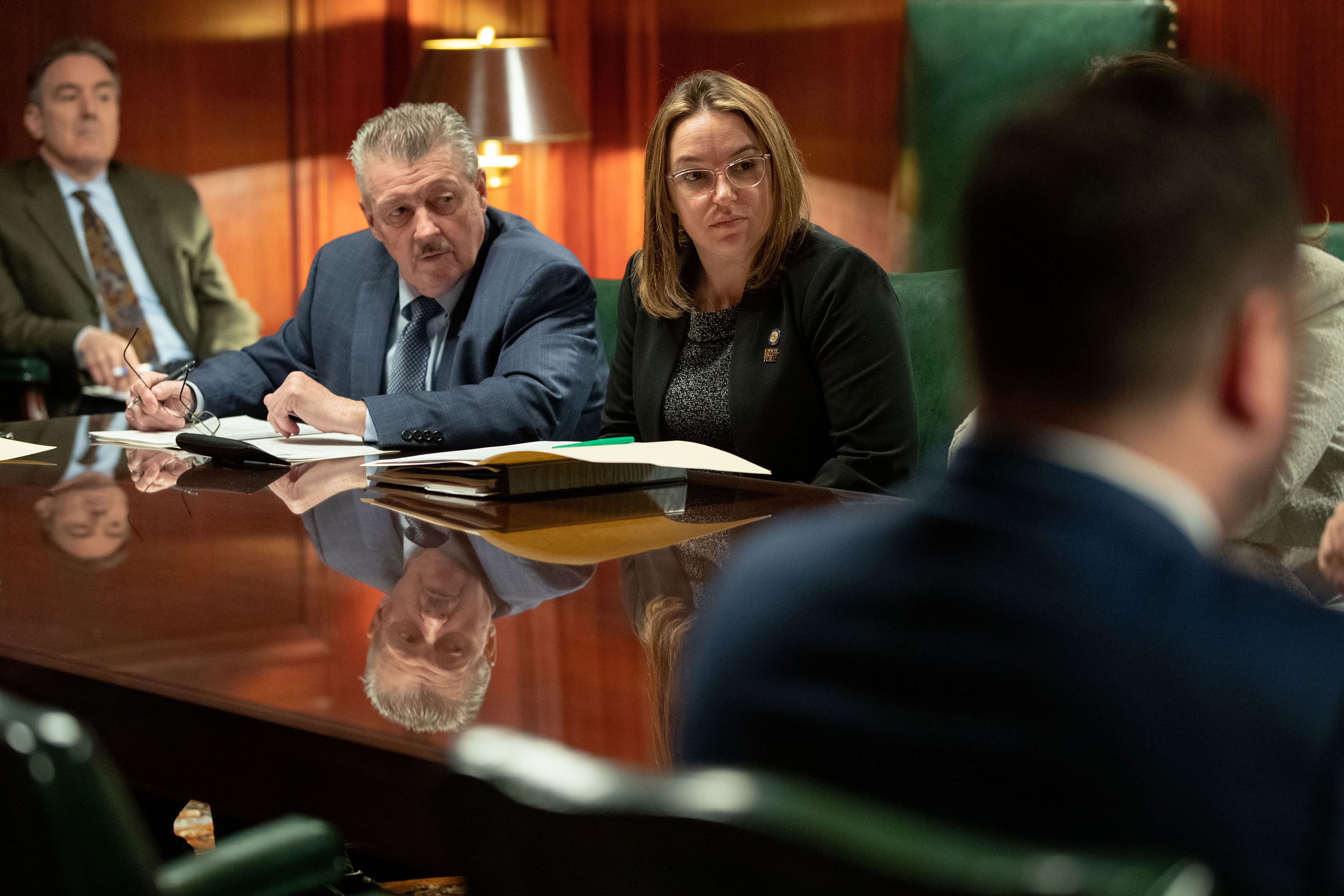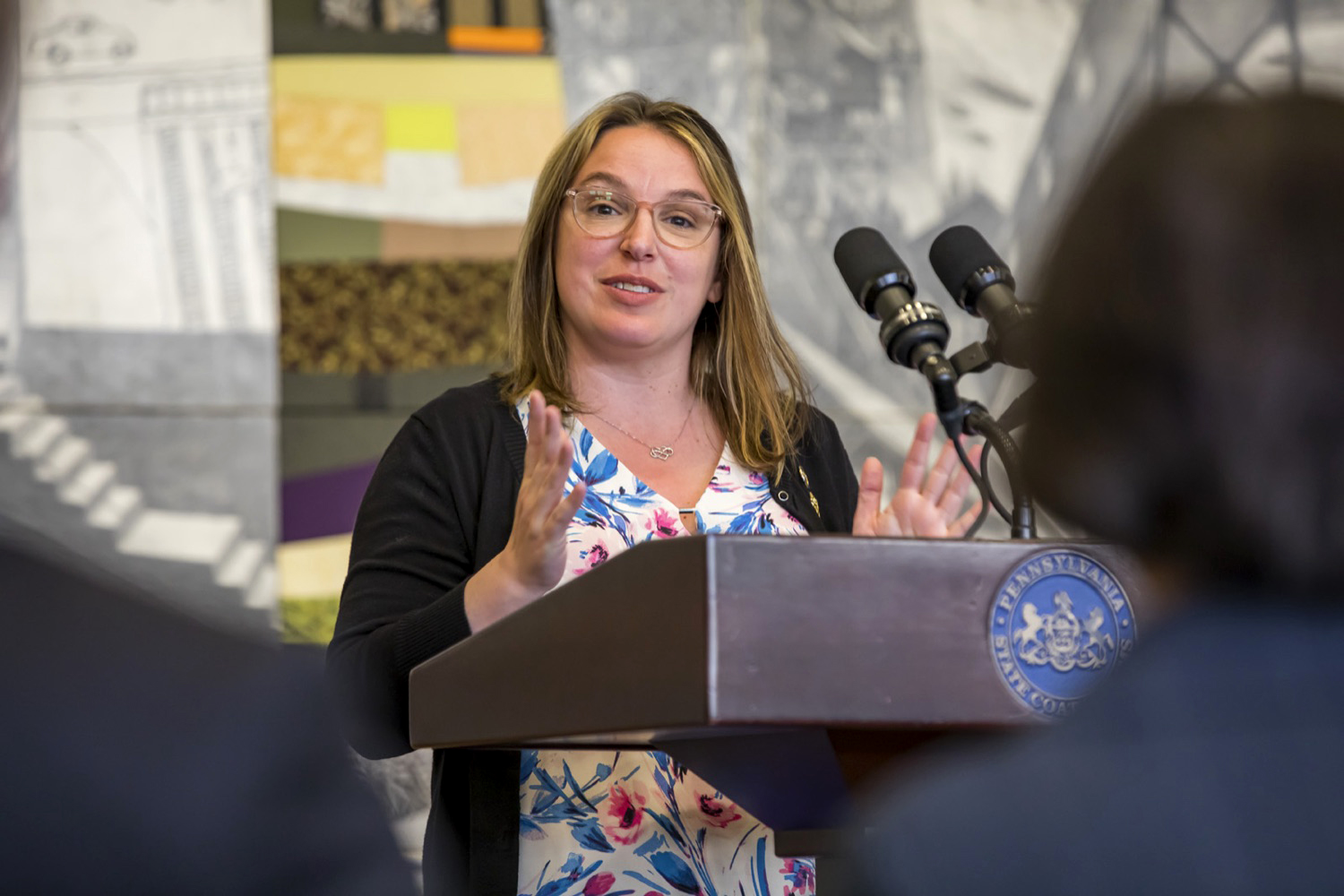Capitol Beat
‘We have a lot of work to do”: A Q&A on education with state Sen. Lindsey Williams
Williams talks with City & State about the work of the Basic Education Funding Commission and how lawmakers should address all things education.

State Sen. Lindsey Williams Chandler Crowell
When Pennsylvania’s Basic Education Funding Commission met on Jan. 11 to consider two different plans on how to remedy the state’s public education funding system, Democratic state Sen. Lindsey Williams was the only lawmaker to vote against both reports.
Williams, who serves as the minority chair of the Senate Education Committee, told City & State that she was hoping to see a more comprehensive vision for the state in the wake of the Commonwealth Court’s 2023 ruling that Pennsylvania’s public school funding system is unconstitutional. In the days following the meeting, Williams spoke with City & State about the BEFC’s statewide tour, why she voted against reports from Democrats and Republicans and what she thinks it’s going to take to properly respond to the court’s decision.
This interview has been edited and condensed for length and clarity.
I want to look back on the statewide tour that the commission embarked on over the last several months. What did you take away from that tour?
We have a lot of work to do. Regardless of where we were in the state and the size of the school district, we heard some of the same themes throughout – that they are struggling with the underfunding. If you’re underfunding special education, if they don’t have those costs covered, they’re going to take from somewhere else. They’re going to take from facilities upgrades, or career and tech ed, or mental health supports. They are struggling to keep up and they have some of the same challenges.
We heard that they have outdated buildings. You have Philadelphia, where you’re seeing mold and asbestos; in other districts, you may not be seeing mold, but you may be seeing buildings that are 200-plus years old that have outdated HVAC systems. They’re not big enough. They’re not adequate for the way kids learn now.
Those are all costs that are being put more and more onto local taxpayers, and that has created and exacerbated an inequitable funding system that the court pointed to. We saw what the court said: You have to fully fund all of these pieces in order to provide a thorough and efficient system of public education.
At the Jan. 11 Basic Education Funding Commission meeting, you were the only lawmaker to vote against both reports presented to the commission. Why?
One, I didn’t see the Republicans’ report until I sat down. Two, with what I was looking at from the Democrats-only report, it didn’t meet what I was seeing as a vision for public education here in Pennsylvania, because it was responding to parts of the court decision like the adequacy part, but it didn’t have the dollar amounts for pre-K, facilities, other educator supports – just to name a few that are a part of that. It wasn’t really setting an aggressive timeline.

It’s one thing if you are voting on a bipartisan report, where there’s a give-and-take so that you can move the whole package forward. In this instance, it was looking more like what will serve as the starting point for budget negotiations, and I didn’t want the public to look at a unanimous, Democrat-only report and say, “Those are our shared goals for the budget,” because in some ways, the Democratic report is closer to my floor – in terms of what I’d like to see – and not a ceiling.
So I don’t want to look and say I’m OK not putting a dollar amount on what we’re investing in the teacher pipeline, because if we put in a whole bunch of money and we don’t have enough staff to fill those jobs, it’s not going to help those kids. I wanted to look at it holistically – and that’s not what we were doing in that report.
You mentioned pre-K and facilities and the timeline – what else would you have liked to see in the report?
Some hard numbers and choices on the issue with charter school funding. In years past, these commissions haven’t had a court decision saying you are unconstitutionally underfunding and inequitably funding our school system. So this was a time for this commission to do something bold, something different, and put those suggestions as concrete, real suggestions for a meaningful and aggressive timeline to actually respond to the court’s whole decision.
What would you like that timeline to look like?
I think it would differ – if it’s seven years, are you frontloading it? Are you putting more of the investment in the first couple of years and spreading the last of it out? There’s wiggle room, but in this report – in either version – it’s seven years with no indication of how that money is pushed out over those seven years. We only have the governor we have for the next three. We can’t say that anything will happen after three years; there has to be some consideration of what that means for the kids who have been in generations of an unconstitutional system. I would have liked to see something about a down payment, because it is a remedy. That’s one piece.
Taking a step back, the report focused on the remedy going backward – the adequacy amount – which is important and a big piece of the court decision. But as a legislator, I also have to look forward. I have to make sure that we’re doing enough so that in five, 10 or 15 years, our schools are not going back to court because we didn’t fix structural issues, such as charter school funding, facilities, payments and special education costs.
The report mentioned $5.4 billion as the statewide adequacy gap. What is the concept of “adequacy” and where does that number come from?
That was based on Penn State Professor Matt Kelly’s testimony in the first hearing … it looks at the total cost of what it would take to educate a student and bring them up to achievement on a variety of levels. He did a very detailed statistical analysis of the school districts that are reaching achievement levels and what they are spending per student, and what it would look like to get districts that aren’t meeting achievement levels up to that achievement level.
Where is that kind of money coming from?
There are a couple of ways we could do that. Do you spend some of the Rainy Day Fund? I’m not saying all of it – but there is a lot of money sitting there. How do you use those funds? We have (the option of) clawing back some of the money that we’ve spent privatizing education like the Educational Improvement Tax Credit and Opportunity Scholarship Tax Credit programs that we just expanded. We’ve spent $2 billion on that. I would say not spending any money on new voucher programs, such as PASS or Lifeline. There are also things like legalizing adult-use cannabis. There are ways to talk about the revenue, but the fact of the matter is that the court ordered us to figure out how to get to that dollar amount.

Not all of it has to be the state share – the court has talked about some onus on local districts that are not taxing. I’d say the bulk of it is the state’s share, because that’s what has to come from the equity piece, but there are a lot of ways where we can look at our state spending to come up with those dollar amounts. It doesn’t have to be done in one year; it can be spread out.
Is there anything you would like to see in this year’s budget to make a dent in the education funding landscape?
I think we need to make an aggressive down payment on fixing decades of unconstitutionality. What we’ve called “historic” over the last couple of years has barely kept up with inflation. So I think we have to start actually getting down to what it means to fully invest in our public schools, in everything from special ed, pre-K, all the way through to higher-ed. I would like to see that investment across the board in public education.
NEXT STORY: This week’s biggest Winners & Losers
